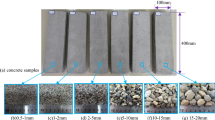Abstract
We investigated elastic wave attenuation characteristics using a PCI-2 acoustic emission system. A lead-break test was employed to carry out attenuation experiments in granite, marble, red sandstone, and limestone. Because the centroid frequency variation of the red sandstone differs significantly from the other rocks, a pendulum steel ball impact test was also performed to study the attenuation characteristics of elastic waves in red sandstone. The results show that the elastic wave signal amplitude decreases with increasing propagation distance for all four rock types. In granite and red sandstone, the peak frequency of the elastic wave declines abruptly after the propagation exceeds 800 and 100 mm, respectively, and remains almost unchanged in marble and limestone. The attenuation of centroid frequency in granite, limestone, and marble shows the same trend; however, in red sandstone, when the elastic wave propagation exceeds a certain distance, the variation of centroid frequency shows an upward tendency. The main influence of elastic wave attenuation in rock is the packing state of mineral particles: less tightly packed rocks consistently have a higher attenuation coefficient. The secondary cause of attenuation is the development of structures such as joints and stratifications. More developed interior structures lead to higher attenuation coefficients. Sensor selection is also very important in rock attenuation tests. We recommend use of a wide resonant frequency sensor or sensors with different resonant frequencies along the elastic wave propagation path.
Similar content being viewed by others
References
Hardy, J.H.R., Acoustic Emission/Microseismic Activity, A.A. Balkema Publishers, USA, 2003.
An, Y., Mu, Y.G., and Fang, C.L., Relationship between Attenuation, Velocity of Sedimentary Rocks and Petrophysical Property, J. Oil Geoph. Prosp, 2006, vol. 41, no. 2, pp. 188–192.
Bai, X.Y., The Study on Method of Layer Absorbing Parameters Extraction Based on the Theory of Seismic Wave Attenuation, China University of Petroleum, 2008.
Toksoz, M.N., Johnston, D.H., and Timur, A., Attenuation of Seismic Waves in Dry and Saturated Rocks: I. Laboratory Measurements, J. Geoph, 1979, vol. 44, no. 4, pp. 681–690.
Futterman, W.I., Dispersive Body Waves, J. Geoph. Res., 1962, vol. 67, no. 13, pp. 5279–5291.
White, J.E., Commuted Seismic Speeds and Attenuation in Rocks with Partial Saturation, Geoph., 1975, vol. 40, no. 2, pp. 224–232.
Knopoff, L. and Macdonald, G.L., Attenuation of Small Amplitude Stress Waves in Solids, Rev. of Modern Phys, 1958, vol. 30, no. 4, pp. 1178–1192.
Biot, M.A., Theory of Propagation of Clastic Waves in a Fluid-Saturated Porous Solid-Low Frequency Range, J. of the Acoustical Society of America, 1956, vol. 28, no. 2, pp. 168–178.
Engelhard, L., Determination of Seismic-Wave Attenuation by Complex Trace Analysis, J. Geoph, 1996, vol. 125, no. 2, pp. 608–622.
Parra, J.O., The Transversely Isotropic Poroelastic Wave Equation including the Biot and the Squirt Mechanisms Theory and Application, J. Geoph., 1997, vol. 62, pp. 309–318.
Parra, J.O., Poroelastic Model to Relate Seismic Wave Attenuation and Dispersion to Permeability Anisotropy, J. Geoph., 2000, vol. 65, no. 1, pp. 202–210.
Tonn, R., The Determination of the Seismic Quality Factor Q from VSP Data: A Comparison of Different Computational Methods, J. Geoph, 1991, vol. 39, no. 1, pp. 1–27.
Shi, X.J., Lu, Z.G., and Xu, H.M., The Attenuation Characteristic of Rock’s Non-Linear Fracture, Chinese J. Geoph, 1996, vol. 39, no. Z, pp. 231–237.
Jin, Z.Q. and Sun, Z.D., Attenuated Travel Time Tomography Method for Estimation of Seismic Attenuation, J. Appl. Geoph, 2017, vol. 139, pp. 73–78.
Feng, J.J., Wang, E.Y., Chen, L., Li, X.L., Xu, Z.Y., and Li, G.A., Experimental Study of the Stress Effect on Attenuation of Normally Incident P-Wave through Coal, J. Appl. Geoph., 2016, vol. 132, pp. 25–32.
Li, Z.M., Gou, X.T., Jin, W.D., Qin, N., and Liu, J.B., Frequency Features of Microseismic Signals, Chinese J. Geotech. Eng., 2008, vol. 30, no. 6, pp. 830–834.
Lockner, D., The Role of Acoustic Emission in the Study of Rock Fracture, J. Rock Mech. and Min. Sci. and Geomech. Abstracts, 1993, vol. 30, no. 7, pp. 883–899.
Vinogradov, S.D., Acoustic Observations in Collieries of the Kizelsk Coal Basin, Bulletin, Izvestiya, Academy of Sci. of the USSR, Geoph. Series, 1957, no. 6.
Vinogradov, S.D., Experimental Study of the Distribution of Fractures in Respect to the Energy Liberated by the Destruction of Rocks, Bulletin, Izvestiya, Academy of Sci. of the USSR, Geoph. Series, 1962, pp. 171–180.
Bucheim, W.W., Geophysical Methods for the Study of Rock Pressure in Coal and Potash Salt Mining, Int. Strata Control Congress, Leipzig, 1958.
Winkler, K.W. and Nur, A., Effects of Pore Fluids and Frictional Sliding on Seismic Attenuation, J. Geoph, 1982, vol. 47, no. 1, pp. 1–12.
Ma, A.J. and Liu, Y., A Summary of Research on Seismic Attenuation, J. Progress in Geoph., 2005, vol. 20, no. 4, pp. 1074–1082.
Zou, Y.H., Wen, G.C., Hu, Q.T., and Xu, J.P., Theory Analysis and Experimental Study of the Spread and Attenuation of Acoustic Emission in Rock Body, J. China Coal Society, 2004, vol. 29, no. 6, pp. 663–667.
Li, H.B., Zhao, W.Z., Cao, H.F., Yao, C., and Shao, L.Y., Characteristic of Seismic Attenuation of Gas Reservoirs in Wavelet Domain, Chinese J. Geoph., 2004, vol. 47, no. 5, pp. 892–898.
Liu, W.G., Wang, J.M., Gu, H.B., Yu, R.G., and Pang, B.J., Attenuation of Acoustic Emission Signals from Hypervelocity Impact on Al Plates, Nondestructive Testing, 2012, vol. 34, no. 12, pp. 41–45.
Funding
The study was supported by the National Key R&D Program of China, project no. 2016YFC0600706, the Natural Science Foundation of Hunan Province, project no. 2016JJ3148, and the postgraduate Independent Exploration and Innovative Project of Hunan Province, project no. CX20190223.
Author information
Authors and Affiliations
Corresponding author
Additional information
Published in Fiziko-Tekhnicheskie Problemy Razrabotki Poleznykh Iskopaemykh, 2020, No. 2, pp. 65–74.
Rights and permissions
About this article
Cite this article
Liu, X.L., Han, M.S., Li, X.B. et al. Elastic Wave Attenuation Characteristics and Relevance for Rock Microstructures. J Min Sci 56, 216–225 (2020). https://doi.org/10.1134/S1062739120026674
Received:
Revised:
Accepted:
Published:
Issue Date:
DOI: https://doi.org/10.1134/S1062739120026674




